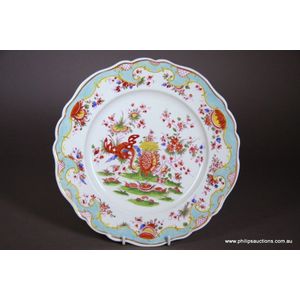Rare Arcadian Polychrome Plate by William Bourne
You must be a subscriber, and be logged in to view price and dealer details.
Subscribe Now to view actual auction price for this item
When you subscribe, you have the option of setting the currency in which to display prices to $Au, $US, $NZ or Stg.
- Salt Glazed - Salt glazing involves throwing salt into the kiln when it is at its highest temperature, usually around 2,300 to 2,400 degrees Fahrenheit (1,260 to 1,320 degrees Celsius). The salt vaporizes and forms a glaze on the surface of the pottery, creating a range of effects depending on how the salt is applied and the firing conditions. This glazing method was first developed in Germany in the 15th century and quickly became popular throughout Europe and North America. It was particularly popular for making stoneware pottery, such as jugs, crocks, and other utilitarian objects.
Salt glazes can produce a range of colors, including gray, brown, blue, and even pink or purple in some cases. The texture of the glaze is typically rough and pebbled, with a matte or satin finish. The process of salt glazing can be unpredictable, with variations in temperature and salt application leading to subtle variations in the finished product.
Salt glazing is still used by potters and ceramic artists although it is less common than it was in the past. - Basket Weave / Basketweave - Basket weave is a decorative pattern that is often used in textiles, ceramics, furniture and other decorative arts. It is created by actual or simulated interweaving of horizontal and vertical threads or strips to create a pattern that resembles a woven basket.
In textiles, basket weave can be created using various materials such as fabric, yarn, or ribbon. It is often used to create decorative details on clothing, upholstery, and other household items. Simulated basket weave can also be created using ceramic clay, timber or other materials, and it is often used to decorate pottery, tiles, furniture, silver and other decorative objects.
Basket weave patterns can vary in complexity, from simple, straightforward designs to more intricate, elaborate patterns. The size and spacing of the interwoven threads or strips can also be varied to create different effects. Basket weave is often used to create a natural, rustic look and is often associated with traditional crafts and folk art. - Circa - A Latin term meaning 'about', often used in the antique trade to give an approximate date for the piece, usually considered to be five years on either side of the circa year. Thus, circa 1900 means the piece was made about 1900, probably between 1895 and 1905. The expression is sometimes abbreviated to c.1900.
- Emeralds - Emeralds have been used in jewellery making for thousands of years, and are prized for their deep green colour, which is caused by the presence of chromium and vanadium in the mineral beryl. Because of their rare colour, emeralds are often more valuable than diamonds of a similar size and quality. In jewellery making, emeralds are typically cut into round or oval shapes to maximize their color and clarity. They are often set in gold or platinum and used as the centrepiece of a piece of jewellery, such as a ring or necklace. They can also be used in combination with other gems, such as diamonds, to create intricate and beautiful designs.
- Polychrome - Made or finished in many colours. For furniture, it is used to indicated a painted finish.
- Arcadian Landscape / Setting / Scene - An Arcadian landscape is a type of landscape that is characterized by its peaceful, idyllic, and rustic setting. It is often associated with the idealized countryside of ancient Greece, and it is often depicted as a rural landscape with rolling hills, forests, streams, and meadows. Arcadian landscapes are often depicted in art and literature as being a place of retreat, where people can escape the stresses and demands of modern life and find a sense of peace and solitude. They are often associated with the concept of Arcadia, which was a region of ancient Greece that was known for its beauty and tranquility.
This item has been included into following indexes:
Visually similar items

A Worcester floral decorated plate, circa 1785, unmarked, plate has a notable green translucency, a lobed gilt-edged plate polychrome decorated with a posy and various sprigs, diameter 22 cm

19th century Minton porcelain plate with hand painted and gilding decorations

A Chamberlain Worcester 'Jabberwocky' plate, circa 1816-1820, pattern 1713, the scallop edged plate with a rococo inspired aqua border with cellular patterns enclosing a fantastic bird in a highly ornamental stylised garden in iron red, mid green and yello

Royal Worcester blush ivory oval plate
